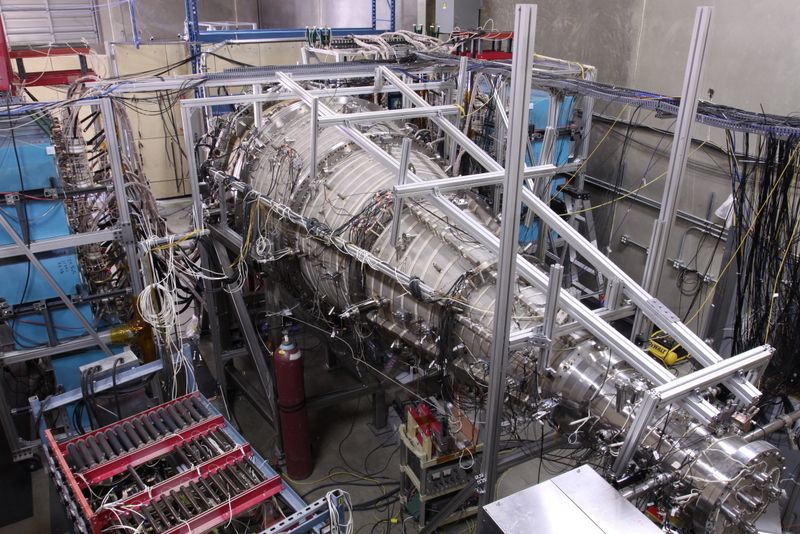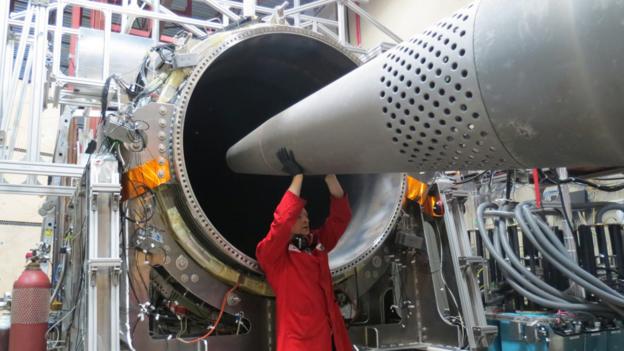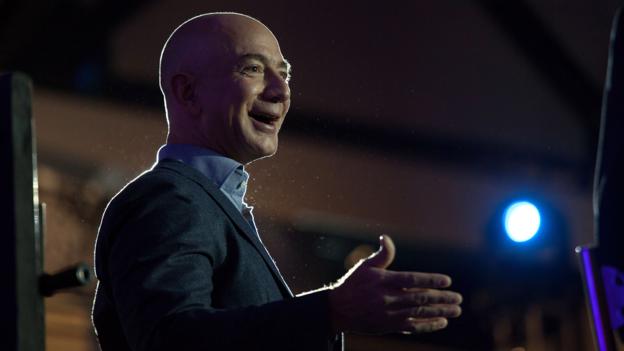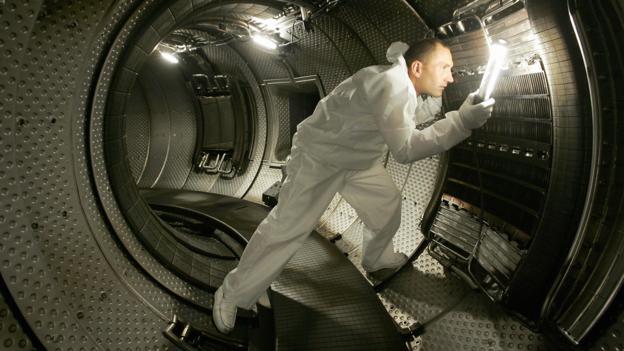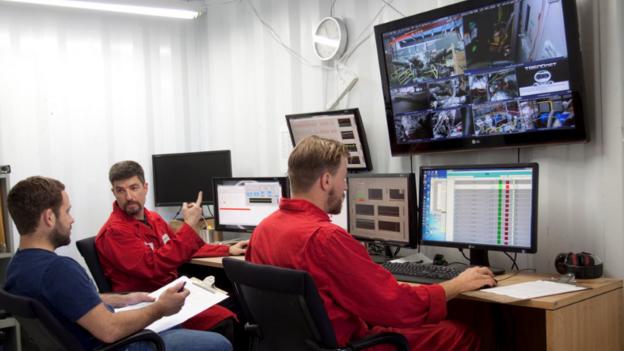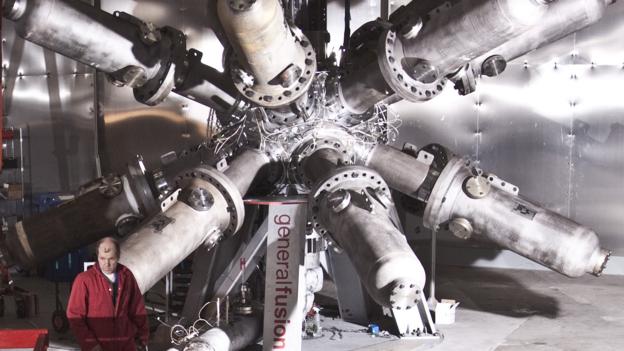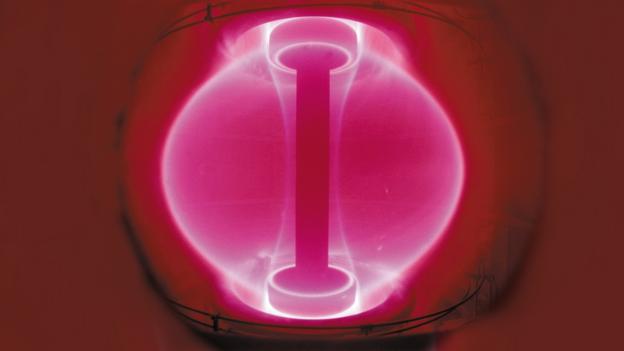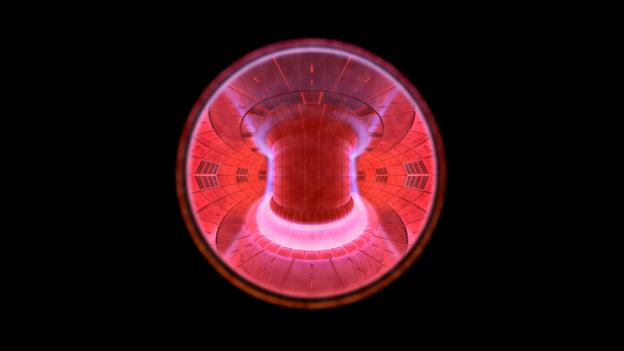The secretive, billionaire–backed plans to harness fusion
The founders of Amazon and Microsoft are putting their fortunes into little-known fusion energy companies. Jonathan Frochtzwajg digs into a story that has strange parallels with fiction.
Inside a laboratory near Vancouver in British Columbia, an alarm is blaring. In the middle of the industrial warehouse stands what looks like a cannon from a spaceship, about five metres long and festooned in wires.
None of the lab’s red-coat-wearing technicians seem fazed by the noise. The siren, which alerts workers to don protective earmuffs in case of a blown fuse, precedes every test “shot” on this prototype nuclear fusion reactor – and these engineers have performed well over 50,000 shots over the past five years.
That speed – currently, 50 to 100 tests a day – would not be possible within the bureaucracy of a public lab, where the most prominent research in long-awaited fusion energy is being conducted. But this is a little-known company called General Fusion – funded by Amazon CEO Jeff Bezos, and free to pursue technological revolution at its own, breakneck pace.
The combination of wealthy moguls and fusion is curiously reminiscent of the 2012 Batman movie The Dark Knight Rises
General Fusion is just one of a pack of private fusion firms to catch the attention of physicists and investors. Unencumbered by red tape, these venture-backed companies believe that they can find a faster, cheaper way to fusion than government-sponsored projects, and some very influential people agree: besides Bezos, Microsoft cofounder Paul Allen and PayPal cofounder Peter Thiel are also backing firms at the forefront of fusion development. Some of these enterprises are rather shadowy: the company Allen is invested in, Tri Alpha, operated for years almost entirely in secret – until recently, it didn’t even have a website.
The combination of wealthy moguls and fusion is curiously reminiscent of the 2012 Batman movie ‘The Dark Knight Rises’, in which Bruce Wayne’s company builds a fusion reactor behind closed doors. The movie wouldn’t win any awards for scientific accuracy, but it got at least one thing right: this world-changing technology may indeed be ushered into existence by a moonshot-minded magnate.
To many of us, fusion, whose advent has been predicted and postponed as many times as doomsday, is still far from reality. To these uber-successful businessmen, it’s a good bet. What do they know that we don’t?
For those whose memory of high-school physics is failing them: fusion is the process of smashing together atomic nuclei in order to combine them. In the course of this reaction, some of the mass of the nuclei is converted into energy – a lot of energy. Fusion is the mechanism that fuels the sun, and an uncontrolled fusion reaction (catalysed by a separate, fission reaction) yields much of an H-bomb’s awesome power.
If that power could be harnessed, fusion would make an almost too-good-to-be-true energy source. The reaction itself requires no fossil fuels and the only byproduct is harmless helium. (While the most feasible type of reaction would cause the material encasing it to become radioactive, this radioactivity would die out more quickly than the by-products of more traditional nuclear power plants.)
The plans of Silicon Valley billionaires have strange parallels with Bruce Wayne of the Batman movie trilogy (Credit: Alamy)
Scientists haven’t been able to figure out a way to get more energy out of a reaction than they put in
The problem is, overcoming the forces that cause nuclei to repel each other requires a massive amount of energy, and so far, scientists haven’t been able to figure out a way to get more energy out of a reaction than they put in. Physicists and engineers have been at work on this thorny question for decades – during which time most laypeople have either forgotten about fusion or dismissed it as a thing of the distant future.
Scientists are making progress. They point to the fact that the rate at which they’ve increased fusion energy output is greater than that of Moore’s Law, the famed predictor of computing power. They also cite Iter, an enormous, internationally-funded fusion reactor currently under construction in southern France; when completed, it will theoretically produce 10 times as much energy as it needs to run. Designed according to the most well-established fusion science, Iter is widely seen as the surest way to fusion power – its name is even a play on the Latin for “the way,” singular – and the project correspondingly receives much of the world’s government fusion funding. But even supporters bemoan the bureaucracy of the seven-entity collaboration; Iter is billions over budget and years behind schedule, with the first reactor experiments not expected until at least 2025.
Enter the Bruce Waynes of the world. The approaches that people like Bezos and Allen are backing are long shots compared with Iter, prioritising engineering simplicity over scientific certainty. But with high risk comes the potential for high reward: an economical, scalable design for a fusion reactor is the kind of globe-altering idea that could earn an investor a lot of money – and, perhaps even more valuable amid Silicon Valley’s boom and bust, an enduring legacy.
Maybe that’s what Jeff Bezos saw when he invested in General Fusion. The Amazon chief executive, known for spending his wealth on grandiose projects, took a stake in the company in 2011 as part of a $19.5 million funding round.
Bezos’s minimalist website doesn’t offer a phone number, and emails went unanswered
Whether Bezos seeks investment return or glory is unclear. His fund’s minimalist website doesn’t offer a phone number, and emails asking for comment for this story went unanswered. Michael Delage, General Fusion’s vice president of technology and corporate strategy, offered his own perspective on the motivations of Bezos though:
“My sense is, he sees the opportunity for entrepreneurship to crack some of these big problems – look what he’s doing with his [manned spaceflight] company, Blue Origin,” Delage says. “At the same time, I think he sees that it can be difficult to find investors because of the scale of the challenges. He has invested in technologies that might not fit with the traditional venture-capital model, but that he still thinks should be supported because they could have a big impact.”
While Bezos may be General Fusion’s best-known investor, he’s far from the only one sold on the company: other contributors to the firm’s more than $81 million in funding include clean-energy venture-capital firm Chrysalix; Canadian oil giant Cenovus; and Khazanah Nasional Berhad, the Malaysian government’s investment arm.
A worker inside a plasma heating system in a more traditional government-funded fusion reactor design (Credit: Getty Images)
The concept that’s attracting all this capital isn’t original; an idea similar to General Fusion’s was studied by the US Naval Research Laboratory in the 1970s. But it took a plasma physicist in the throes of a midlife crisis to dust off the old designs and recognise how modern technology could again make them relevant.
The year was 2001, and Michel Laberge, General Fusion’s founder and chief scientist, had recently quit his increasingly unchallenging job at the laser-printing company Creo to take on bigger issues.
It took a plasma physicist in the throes of a midlife crisis to dust off the old designs
“I knew that we had a bit of a problem with energy on this planet, and I knew that fusion would be the solution,” remembers Laberge, a Quebec native who didn’t learn English until he was 25 and still speaks with a heavy accent. “So, at my 40-year-old birthday, I quit my job and decided to do fusion.”
At Creo, Laberge had learned how to apply his physics knowledge – he has a PhD in plasma physics – to real-world product development. “I became a more concrete, practical dude,” he says. He also saw how a small company willing to stray off the beaten path can cut larger organisations off at the pass. “If you do the same as the other guy, and he’s [spending] billions of dollars on it, you’re not going to beat them – but if you do something slightly different, it has a chance of working.”
Laberge knew there were lots of off-path fusion approaches out there. “All those alternative ways of doing fusion were very little supported,” he explains, because the mainstream methods “were swallowing up most of the resources.” The approach he decided to pursue, called “magnetised target fusion,” was one such alternative.
Workers monitor tests at General Fusion – there have been thousands already (Credit: General Fusion)
Here’s how it works: first, magnetic fields are used to confine a superheated plasma of volatile deuterium and tritium isotopes. This plasma is then injected into a sphere, where it’s briefly contained in a vortex of liquid metal. Next, pistons converging towards the centre of the sphere simultaneously strike an anvil at the end of their cylinder, sending a shock wave into the plasma. This burst of energy causes the plasma to compress and the deuterium-tritium fuel to ignite – producing, in theory, a tremendous burst of energy.
You can watch a short animation illustrating the process below:
Importantly for investors, General Fusion’s reactor doesn’t demand state-of-the-art lasers or football-field-sized facilities, like the government-funded projects that Bezos, Laberge and company are seeking to outpace.
If this design is so great, why was it abandoned? When the newly unemployed Laberge unearthed old patents related to the idea, he saw the presumptive reason. Picture a balloon: if you compress it at one point more than at any other, it’s likely to pop. A plasma is similar; if it’s not compressed uniformly, it essentially falls apart. To work, the pistons must strike the anvils at precisely the same time. Laberge realised that you could only achieve that synchronicity with modern-day computers.
Supporting himself and his family with the proceeds from selling stock in his old company, Laberge spent the next couple of years developing the concept. He eventually built a small prototype – a humble-looking contraption still on display in General Fusion’s reception area – and was able to produce a few neutrons. Laberge calls these his “marketing neutrons”; they were proof enough of his idea to bring in General Fusion’s first significant investments.
Watch Michel Laberge’s 2014 TED talk:
Today, the company has some 65 employees and occupies two buildings in an unassuming office park near Burnaby Lake. Leading me into the high-ceilinged, cement-floored space behind the firm’s offices, the now 54-year-old Laberge presents General Fusion’s prototype reactor, a spiky sphere about four metres in diameter which looks a lot like a giant naval mine. Nearby are the “spaceship cannons,” which inject plasma into the sphere. Wires protrude from everything, transmitting reams of data to computers in a loft above for analysis.
Laberge says the company has adjusted the design of its reactor countless in the last few years. It’s a sobering reminder of the enormity and complexity of General Fusion’s undertaking that, more than a decade after its founding, the company is still working on clearing some fairly early fusion hurdles, like keeping its plasma at a high enough temperature for a long enough period for fusion to take place.
The arms of General Fusion’s prototype reactor, which contain pistons, makes it look like a giant explosive mine (Credit: General Fusion)
“The plasma has lots of crazy ways of getting rid of the heat, and we understand that a lot better than we used to,” Laberge says. But despite progress, plasma temperature remains General Fusion’s greatest challenge. “To control all those physics processes that can happen to cool the plasma down, that’s the name of the game in fusion.”
Ex-physicist Kenneth Fowler, who literally wrote the book on fusion – The Fusion Quest – and who serves on General Fusion’s advisory board, agrees with Laberge’s diagnosis. “The critical issue General Fusion is facing right now,” he says, “is the leakage of heat.” But, Fowler continues, that may be the company’s last major hurdle. “I think they’ve done enough work on all the subsidiary issues that if they get past exactly where they are now, they have a good chance to be on their way.”
Other experts are more circumspect. “Extreme compression” – the process General Fusion is trying to achieve with plasma – “is very, very hard to control,” says Michael Zarnstorff, deputy director for research at the US government-funded Princeton Plasma Physics Laboratory. “That’s going to be a long, arduous thing to work on at General Fusion, I expect.”
Compression in the reactor at General Fusion must be timed perfectly otherwise the reaction will fail (Credit: General Fusion)
In the end, General Fusion’s success may depend on whether it can keep its investors’ interest
In the end, General Fusion’s success may depend not on whether it can keep its plasma hot, but on whether it can keep its investors’ interest. On a long-enough timeline, and with a big-enough budget, Laberge gives his company a 90% chance of succeeding. But venture capitalists’ patience is limited. “Eventually, the investor will get bored,” he says.
If General Fusion fails, it’ll be because, “someone gets tired of funding them because it took longer than the timeline of the investor to sort out the vagaries of plasma physics”, Fowler declares. “If this idea will work, I believe they will make it work.”
**
Around 1,300 miles (2000km) south of General Fusion’s headquarters, you’ll find another firm in the vanguard of venture-backed fusion – or, more likely, you won’t. Tri Alpha Energy, based in Orange County, California, has been notoriously secretive since it was founded in 1998: until last year, it had no public address, no readily available contact information – not even a website. Two of the company’s scientists approached for this story did not reply. This low profile hasn’t kept investors from noticing the company: Tri Alpha’s backers include Paul Allen; the Rockefeller family’s venture-capital firm, Venrock; and the Russian government’s nanotech-investment arm, Rusnano. (In keeping with the theme of secrecy, Allen’s company, Vulcan Inc, doesn’t list Tri Alpha in its investment portfolio, and a Vulcan spokeswoman declined requests to interview someone there about the fusion firm.)
It’s unclear why Tri Alpha has been so hush-hush. After all, some of General Fusion’s technology is proprietary, but the firm isn’t at all tight-lipped. Delage – who claims that other energy industries and “Mother Nature” pose greater competition than fellow fusion companies – says General Fusion decided to be public-facing in order to build credibility and engage scientists, but it still keeps some information private. “I don’t think an approach needs to be all-or-nothing,” he says.
Maurice Gunderson, a veteran energy-sector venture capitalist, guesses that Tri Alpha’s public-relations strategy – or lack thereof – is just a matter of style. “Frankly, they’re not selling a product, so they don’t have to attract customers,” he reasons. “And maybe they’ve got enough investors around the table that they don’t need to attract more.”
Tri Alpha is taking an engineering-first, physics-later approach to fusion
Whatever the reason for their secrecy, in recent years, Tri Alpha has been less cagey about its efforts; in addition to establishing a web presence, its researchers have begun to speak about their work publicly, sketching a picture of the approach the firm is taking. Tri Alpha has staked its claim on a reactor design called a “field-reversed configuration.” This type of device has more in common with Iter’s tokamak-style reactor than General Fusion’s machine: it uses magnetic confinement and heat, rather than compression, to induce fusion, and it produces energy continuously, instead of in bursts.
The advantage of a field-reversed configuration over a tokamak is that its engineering is much simpler. But from a physics perspective, the technology is far less well-developed. Zarnstorff, who has visited Tri Alpha’s headquarters, says the company is still “orders of magnitude away” from the plasma temperatures and confinement times needed for fusion.
To make matters more difficult, Tri Alpha is aiming to use a fuel made up of the isotope boron-11 and a proton, rather than the more basic deuterium-tritium blend. This fuel would produce less radioactivity than deuterium-tritium, but would demand much higher temperatures, and experts are dubious of its feasibility. “That is so extremely difficult, I’m not sure anybody will ever be able to do it,” Fowler says.
Like other private fusion firms – and in contrast to public efforts – Tri Alpha is taking an engineering-first, physics-later approach to fusion, says Zarnstorff. “They’re almost saying, if I simplify it in these ways, can I get it to work?”
He’s a sceptic, but not a naysayer.
“We’re making judgments based on what we think is simple to do and hard to do, but the reality is, nobody’s succeeded,” he says. “And nobody’s succeeded, especially, in making something that’s commercially attractive. So, one has to be a little forbearing – and encouraging, really – of people trying to go beyond just doing the basic science.”
In venture-capital, you see thousands of business plans, and some of them are really nutty. These ones are not really nutty
In spite of the barriers its concept faces, Tri Alpha has been resoundingly successful in attracting capital. What’s the draw? Venture capitalist Gunderson got a peek at a business plan for the company when it was still young, and though he sees any fusion endeavour as a long-shot, Tri Alpha’s proposal looked about as credible as they come. (He felt the same way about an early General Fusion business plan.) “I thought they were really interesting – some of the smartest people I’d ever met,” he says. “If you’re in the VC business, you see thousands of business plans, and some of them are really nutty. These ones are not really nutty.”
Government-funded fusion reactors require both giant engineering and international collaboration (Credit: SPL)
Gunderson still passed on Tri Alpha (and General Fusion), for the same reason most venture capitalists would: time. Venture-capital partnerships, he explains, are usually formed as limited partnerships, meaning they have a finite lifetime; the industry standard is a decade. If a company isn’t likely to earn backers a return on their investment in that amount of time, it isn’t a good fit for the VC model. “The saying in venture capital is, if we see a deal that’s going to cure cancer, end war, stop hunger, and make a huge pile of money, and it takes 11 years, we can’t touch it,” he says.
Fusion, with its ever-telescoping timeline, falls into that category. A few venture-capital firms have made bets on private fusion companies – Venrock on Tri Alpha, for example – but in general, these companies aren’t seen as smart gambles.
Gunderson lauds Allen and Bezos for their “investor courage”. “Those people are making a brave bet with a portion of their fortune, and I really respect them for that,” he says.
But when it comes to fusion, billions and business successes may not be enough to overcome the obstacles.
“These are extraordinarily successful people – I mean, look at Amazon, right?” says Gunderson. “But fusion is – pick a number – 1,000 times harder, 10,000 times harder than Amazon.”
Whether some real-world Bruce Wayne will beat the odds – and beat Iter – remains to be seen. But just the fact that private companies and capital are coming into the field is a promising development for fusion. It means that the technology has finally advanced to the point of tangibility. “It’s a sign that we’re getting close,” Zarnstorff says.
It’s also a sign that demand for this non-polluting, abundant energy source may be growing as the threat of climate change becomes ever more palpable.
The secret fusion reactor in Christopher Nolan’s Batman trilogy is adapted to be a bomb…but that possibility is science fiction (Credit: Alamy)
Back at General Fusion’s headquarters, Laberge says he himself was motivated to take on fusion in part out of concern over global warming. “It’s starting to be a bit alarming,” he observes drily, squinting out the window into an unseasonably sunny Vancouver day.
Across town, at Vancouver’s Stanley Park, the city’s residents are taking advantage of the warm weather, promenading en masse along the peninsular park’s seawall. The snow-capped North Shore Mountains practically lean over the city; the Strait of Georgia stretches to the horizon. On one stretch of the park’s popular shoreline, posted signs declare the beach closed due to an oil spill just offshore a few days earlier. The spill is a minor one, but it serves as a pointed reminder of the messiness of the resources the world runs on now. Several Vancouverites look on, seeming a bit shell-shocked, as a cleanup crew works on the rocky beach.
One wonders: will the promise of fusion energy be fulfilled in time to save these mountains from shrinking snowpacks, and this peninsula from pollution and rising sea levels? In this high-stakes race, the government megaprojects may be the world’s best bet – but the tech tycoons are the dark horse it desperately needs.
___
http://www.bbc.com/future/story/20160428-the-secretive-billionaire-backed-plans-to-harness-fusion
